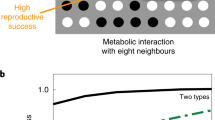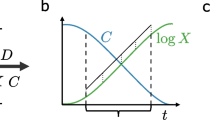Abstract
Gene regulatory networks allow single cells to adopt a wide range of different phenotypes in response to changes in environmental conditions. The ecological implications of these cellular computations are poorly understood, and they are largely absent from models of microbial community assembly. Here, we highlight a number of examples where ecological interactions are or may be affected by cellular computations. Our review identifies specific opportunities for integrating cellular decision-making into mathematical models of microbe-microbe interactions and community assembly. We argue that incorporating cellular decision-making into microbial ecology will be critical in order to gain a quantitative understanding of microbial biogeography.



Similar content being viewed by others
References
Acar M, Mettetal JT, van Oudenaarden A (2008) Stochastic switching as a survival strategy in fluctuating environments. Nat Genet 40:471–475
Ahmer BMM, Gunn JS (2011) Interaction of Salmonella spp. with the Intestinal Microbiota. Front Microbiol 2:101
Aidelberg G, Towbin BD, Rothschild D et al (2014) Hierarchy of non-glucose sugars in Escherichia coli. BMC Syst Biol 8:133
Arnoldini M, Vizcarra IA, Peña-Miller R et al (2014) Bistable expression of virulence genes in salmonella leads to the formation of an antibiotic-tolerant subpopulation. PLoS Biol 12:e1001928
Axelrod K, Sanchez A, Gore J (2015) Phenotypic states become increasingly sensitive to perturbations near a bifurcation in a synthetic gene network. Elife 4:e07935. https://doi.org/10.7554/eLife.07935
Barrick JE, Lenski RE (2013) Genome dynamics during experimental evolution. Nat Rev Genet 14:827–839
Bashan A, Gibson TE, Friedman J et al (2016) Universality of human microbial dynamics. Nature 534:259–262
Beardmore RE, Gudelj I, Lipson DA, Hurst LD (2011) Metabolic trade-offs and the maintenance of the fittest and the flattest. Nature 472:342–346
Beisel CL, Afroz T (2015) Rethinking the hierarchy of sugar utilization in bacteria. J Bacteriol 198:374–376
Blount ZD, Borland CZ, Lenski RE (2008) Historical contingency and the evolution of a key innovation in an experimental population of Escherichia coli. Proc Natl Acad Sci U S A 105:7899–7906
Blount ZD, Barrick JE, Davidson CJ, Lenski RE (2012) Genomic analysis of a key innovation in an experimental Escherichia coli population. Nature 489:513–518
Bohannan BJM, Kerr B, Jessup CM et al (2002) Trade-offs and coexistence in microbial microcosms. Antonie Van Leeuwenhoek 81:107–115
Cavaliere M, Sanchez A (2016) The evolutionary resilience of distributed cellular computing. In: Membrane computing. Springer, Cham, pp 3–15
Chen A, Sanchez A, Dai L, Gore J (2014) Dynamics of a producer-freeloader ecosystem on the brink of collapse. Nat Commun 5:3713
Chesson P (1990) MacArthur’s consumer-resource model. Theor Popul Biol 37:26–38
Desai TA, Rao CV (2010) Regulation of arabinose and xylose metabolism in Escherichia coli. Appl Environ Microbiol 76:1524–1532
Diard M, Garcia V, Maier L et al (2013) Stabilization of cooperative virulence by the expression of an avirulent phenotype. Nature 494:353–356
Diard M, Sellin ME, Dolowschiak T et al (2014) Antibiotic treatment selects for cooperative virulence of Salmonella typhimurium. Curr Biol 24:2000–2005
Dickens B, Fisher CK, Mehta P (2016) Analytically tractable model for community ecology with many species. Phys Rev E 94:022423
Escalante-Chong R, Savir Y, Carroll SM et al (2015) Galactose metabolic genes in yeast respond to a ratio of galactose and glucose. Proc Natl Acad Sci U S A 112:1636–1641
Friesen ML, Saxer G, Travisano M, Doebeli M (2004) Experimental evidence for sympatric ecological diversification due to frequency-dependent competition in Escherichia coli. Evolution 58:245–260
Goldford JE, Lu N, Bajic D et al (2018) Emergent simplicity in microbial community assembly. Science 361:469–474
Granados AA, Crane MM, Montano-Gutierrez LF et al (2017) Distributing tasks via multiple input pathways increases cellular survival in stress. Elife 6:e21415. https://doi.org/10.7554/eLife.21415
Gutiérrez M, Gregorio-Godoy P, Pérez Del Pulgar G et al (2017) A new improved and extended version of the multicell bacterial simulator gro. ACS Synth Biol 6:1496–1508
Hall EK, Singer GA, Kainz MJ, Lennon JT (2010) Evidence for a temperature acclimation mechanism in bacteria: an empirical test of a membrane-mediated trade-off. Funct Ecol 24:898–908
Harcombe WR, Delaney NF, Leiby N et al (2013) The ability of flux balance analysis to predict evolution of central metabolism scales with the initial distance to the optimum. PLoS Comput Biol 9:e1003091
Harrington KI, Sanchez A (2014) Eco-evolutionary dynamics of complex social strategies in microbial communities. Commun Integr Biol 7:e28230
Herron MD, Doebeli M (2013) Parallel evolutionary dynamics of adaptive diversification in Escherichia coli. PLoS Biol 11:e1001490
Hilker M, Schwachtje J, Baier M et al (2016) Priming and memory of stress responses in organisms lacking a nervous system. Biol Rev Camb Philos Soc 91:1118–1133
Høyland-Kroghsbo NM, Maerkedahl RB, Svenningsen SL (2013) A quorum-sensing-induced bacteriophage defense mechanism. MBio 4:e00362–12
Jang SS, Oishi KT, Egbert RG, Klavins E (2012) Specification and simulation of synthetic multicelled behaviors. ACS Synth Biol 1:365–374
Koirala S, Wang X, Rao CV (2015) Reciprocal regulation of l-arabinose and d-xylose metabolism in Escherichia coli. J Bacteriol 198:386–393
Kotte O, Volkmer B, Radzikowski JL, Heinemann M (2014) Phenotypic bistability in Escherichia coli’s central carbon metabolism. Mol Syst Biol 10:736
Lawley TD, Bouley DM, Hoy YE et al (2008) Host transmission of Salmonella enterica serovar Typhimurium is controlled by virulence factors and indigenous intestinal microbiota. Infect Immun 76:403–416
Le Gac M, Brazas MD, Bertrand M et al (2008) Metabolic changes associated with adaptive diversification in Escherichia coli. Genetics 178:1049–1060
Leiby N, Marx CJ (2014) Metabolic erosion primarily through mutation accumulation, and not tradeoffs, drives limited evolution of substrate specificity in Escherichia coli. PLoS Biol 12:e1001789
Levine JM, Bascompte J, Adler PB, Allesina S (2017) Beyond pairwise mechanisms of species coexistence in complex communities. Nature 546:56–64
Li G, Kesler BK, Thiemicke A et al (2017) Linearly changing stress environment causes cellular growth phenotype. bioRxiv 155267
Litchman E, Klausmeier CA, Schofield OM, Falkowski PG (2007) The role of functional traits and trade-offs in structuring phytoplankton communities: scaling from cellular to ecosystem level. Ecol Lett 10:1170–1181
Litchman E, Edwards KF, Klausmeier CA (2015) Microbial resource utilization traits and trade-offs: implications for community structure, functioning, and biogeochemical impacts at present and in the future. Front Microbiol 6:254
Mayfield MM, Stouffer DB (2017) Higher-order interactions capture unexplained complexity in diverse communities. Nat Ecol Evol 1:62
Mehta P, Schwab DJ (2012) Energetic costs of cellular computation. Proc Natl Acad Sci U S A 109:17978–17982
Mitchell A, Pilpel Y (2011) A mathematical model for adaptive prediction of environmental changes by microorganisms. Proc Natl Acad Sci U S A 108:7271–7276
Mitchell A, Romano GH, Groisman B et al (2009) Adaptive prediction of environmental changes by microorganisms. Nature 460:220–224
Mitchell A, Wei P, Lim WA (2015) Oscillatory stress stimulation uncovers an Achilles’ heel of the yeast MAPK signaling network. Science 350:1379–1383
Monod J (1949) The growth of bacterial cultures. Annu Rev Microbiol 3:371–394
Monod J (1966) From enzymatic adaptation to allosteric transitions. Science 154:475–483
New AM, Cerulus B, Govers SK et al (2014) Different levels of catabolite repression optimize growth in stable and variable environments. PLoS Biol 12:e1001764
Perkins TJ, Swain PS (2009) Strategies for cellular decision-making. Mol Syst Biol 5:326
Pos KM, Dimroth P, Bott M (1998) The Escherichia coli citrate carrier CitT: a member of a novel eubacterial transporter family related to the 2-oxoglutarate/malate translocator from spinach chloroplasts. J Bacteriol 180:4160–4165
Posfai A, Taillefumier T, Wingreen NS (2017) Metabolic trade-offs promote diversity in a model ecosystem. Phys Rev Lett 118:028103
Qin X, Sun Q, Yang B et al (2017) Quorum sensing influences phage infection efficiency via affecting cell population and physiological state. J Basic Microbiol 57:162–170
Quandt EM, Gollihar J, Blount ZD et al (2015) Fine-tuning citrate synthase flux potentiates and refines metabolic innovation in the Lenski evolution experiment. Elife 4:e09696. https://doi.org/10.7554/eLife.09696
Ranea JAG, Grant A, Thornton JM, Orengo CA (2005) Microeconomic principles explain an optimal genome size in bacteria. Trends Genet 21:21–25
Regot S, Macia J, Conde N et al (2011) Distributed biological computation with multicellular engineered networks. Nature 469:207–211
Rillig MC, Rolff J, Tietjen B et al (2015) Community priming—effects of sequential stressors on microbial assemblages. FEMS Microbiol Ecol. https://doi.org/10.1093/femsec/fiv040
Robert L, Paul G, Chen Y et al (2010) Pre-dispositions and epigenetic inheritance in the Escherichia coli lactose operon bistable switch. Mol Syst Biol 6:357
Rojo F (2010) Carbon catabolite repression in Pseudomonas: optimizing metabolic versatility and interactions with the environment. FEMS Microbiol Rev 34:658–684
Sanchez A, Gore J (2013) Feedback between population and evolutionary dynamics determines the fate of social microbial populations. PLoS Biol 11:e1001547
Sani E, Herzyk P, Perrella G et al (2013) Hyperosmotic priming of Arabidopsis seedlings establishes a long-term somatic memory accompanied by specific changes of the epigenome. Genome Biol 14:R59
Shank EA, Klepac-Ceraj V, Collado-Torres L et al (2011) Interspecies interactions that result in Bacillus subtilis forming biofilms are mediated mainly by members of its own genus. Proc Natl Acad Sci U S A 108:E1236–43
Singh KD, Schmalisch MH, Stülke J, Görke B (2008) Carbon catabolite repression in Bacillus subtilis: quantitative analysis of repression exerted by different carbon sources. J Bacteriol 190:7275–7284
Skerker JM, Perchuk BS, Siryaporn A et al (2008) Rewiring the specificity of two-component signal transduction systems. Cell 133:1043–1054
Spencer CC, Bertrand M, Travisano M, Doebeli M (2007) Adaptive diversification in genes that regulate resource use in Escherichia coli. PLoS Genet 3:e15
Stein RR, Bucci V, Toussaint NC et al (2013) Ecological modeling from time-series inference: insight into dynamics and stability of intestinal microbiota. PLoS Comput Biol 9:e1003388
Tagkopoulos I, Liu Y-C, Tavazoie S (2008) Predictive behavior within microbial genetic networks. Science 320:1313–1317
Tan D, Dahl A, Middelboe M (2015) Vibriophages differentially influence biofilm formation by Vibrio anguillarum strains. Appl Environ Microbiol 81:4489–4497
Taylor TB, Mulley G, Dills AH et al (2015) Evolution. evolutionary resurrection of flagellar motility via rewiring of the nitrogen regulation system. Science 347:1014–1017
Thiennimitr P, Winter SE, Winter MG et al (2011) Intestinal inflammation allows Salmonella to use ethanolamine to compete with the microbiota. Proc Natl Acad Sci U S A 108:17480–17485
Toll-Riera M, San Millan A, Wagner A, MacLean RC (2016) The genomic basis of evolutionary innovation in Pseudomonas aeruginosa. PLoS Genet 12:e1006005
Turkarslan S, Reiss DJ, Gibbins G et al (2011) Niche adaptation by expansion and reprogramming of general transcription factors. Mol Syst Biol 7:554
Turner CB, Blount ZD, Mitchell DH, Lenski RE (2015) Evolution and coexistence in response to a key innovation in a long-term evolution experiment with Escherichia coli. bioRxiv 020958
van Nimwegen E (2003) Scaling laws in the functional content of genomes. Trends Genet 19:479–484
Venturelli OS, Zuleta I, Murray RM, El-Samad H (2015) Population diversification in a yeast metabolic program promotes anticipation of environmental shifts. PLoS Biol 13:e1002042
Wang J, Atolia E, Hua B et al (2015) Natural variation in preparation for nutrient depletion reveals a cost-benefit tradeoff. PLoS Biol 13:e1002041
Xie L, Wu X-L (2014) Bacterial motility patterns reveal importance of exploitation over exploration in marine microhabitats. Part I: theory. Biophys J 107:1712–1720
Yawata Y, Cordero OX, Menolascina F et al (2014) Competition-dispersal tradeoff ecologically differentiates recently speciated marine bacterioplankton populations. Proc Natl Acad Sci U S A 111:5622–5627
Yi X, Dean AM (2016) Phenotypic plasticity as an adaptation to a functional trade-off. Elife 5:e19307. https://doi.org/10.7554/eLife.19307
Young JW, Locke JCW, Elowitz MB (2013) Rate of environmental change determines stress response specificity. Proc Natl Acad Sci U S A 110:4140–4145
Author information
Authors and Affiliations
Corresponding author
Rights and permissions
About this article
Cite this article
Baskerville, M., Biro, A., Blazanin, M. et al. Ecological effects of cellular computing in microbial populations. Nat Comput 17, 811–822 (2018). https://doi.org/10.1007/s11047-018-9708-8
Published:
Issue Date:
DOI: https://doi.org/10.1007/s11047-018-9708-8




